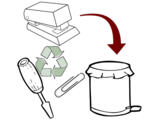
A set of cards with images of the moon to help children learn the names of the moon's different phases.
- Subject:
- Astronomy
- Physical Science
- Material Type:
- Activity/Lab
- Provider:
- Astronomical Society of the Pacific
- Date Added:
- 08/08/2022

A set of cards with images of the moon to help children learn the names of the moon's different phases.

Children match pictures of the Moon on cards with matching pictures on a banner that shows the Moon phase cycle.

Through the NSF-funded My Sky Tonight program, we have created a set of research-based, science-rich astronomy activities that are engaging and developmentally appropriate for pre-K aged children, and trained hundreds of educators at museums, parks, and libraries across the U.S. on how to effectively engage their youngest visitors (ages 3 – 5) in astronomy.

Students use a length of paper to understand the size of the solar system.

Many astronomical images show galaxies, nebulae and other objects in bright rainbow colors, but these are not the colors we would see if looking at these objects with our eyes, since the light from these objects may not be visible to us. Scientists chose the colors in the image to represent the invisible wavelengths of light. This activity explores the ideas of invisible light and representational color and lets participants create their own representational color map of the temperature of a surface.

Un dispositif d'enseignement mi-fini, destiné aux enseignant·e, sur la réparation d'objets de bureau. Les élèves travaillent directement avec les objets, transmis avec une carte-énigme : ils doivent découvrir la panne et la résoudre, et peuvent répondre à des questions subsidiaires.Le dispositif permet d'aborder la technologie en commençant par l'activité manuelle, avec les élèves de 1er ou 2e cycle, ou en classe de soutien.

Children love to sing! Star Song is fun, easy to sing, and scientifically accurate!

Children tell a story about a trip to the beach on a sunny day and investigate ultraviolet (UV) light.

Students use a roll of toiletpaper to understand the size of the solar system.